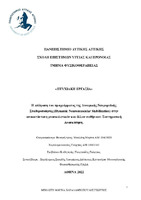| dc.contributor.advisor | Γεωργούδης, Γεώργιος | |
| dc.contributor.author | Μπολέτη, Μαρίνα | |
| dc.contributor.author | Χαραλαμπόπουλος, Γεώργιος | |
| dc.date.accessioned | 2022-10-20T09:52:25Z | |
| dc.date.available | 2022-10-20T09:52:25Z | |
| dc.date.issued | 2022-10-19 | |
| dc.identifier.uri | https://polynoe.lib.uniwa.gr/xmlui/handle/11400/3160 | |
| dc.identifier.uri | http://dx.doi.org/10.26265/polynoe-3000 | |
| dc.description.abstract | Εισαγωγή: Η Δυναμική Νευρομυϊκή Σταθεροποίηση είναι μία παρέμβαση αποκατάστασης που βασίζεται στην εξελικτική κινησιολογία.
Σκοπός: Η διερεύνηση της επίδρασης της ΔΝΣ, σε μυοσκελετικές και άλλες παθήσεις.
Μεθοδολογία: Για την εύρεση σχετικών με το θέμα ερευνητικών άρθρων για την παρούσα συστηματική ανασκόπηση, πραγματοποιήθηκε αναζήτηση στις βάσεις δεδομένων: Medline (Pubmed), Science Direct, Cochrane, Scopus, PEDro και Google Scholar, με τη χρήση συγκεκριμένων λέξεων κλειδιών και καθορισμό κριτηρίων ένταξης-αποκλεισμού. Από τη μελέτη εξαιρέθηκαν οι μελέτες που δεν ήταν γραμμένες στην Αγγλική γλώσσα. Η συστηματική ανασκόπηση διεξήχθη σύμφωνα με τις οδηγίες PRISMA.
Αποτελέσματα: Από την αναζήτηση της αρθρογραφίας , συνολικά προέκυψαν 95 αναφορές. Κατόπιν διαλογής των τίτλων, 39 αναφορές απορρίφθηκαν λόγω αφαίρεσης των διπλότυπων. Εκ της εξέτασης της περίληψης των 56 αναφορών που απέμειναν, διαπιστώθηκε ότι οι 48 δεν ήταν κατάλληλες προς εισαγωγή στην παρούσα συστηματική ανασκόπηση. Οι λόγοι απόρριψης είναι οι κάτωθι: μη τυχαιοποιημένες ελεγχόμενες μελέτες, ασυνάφεια με το υπό διερεύνηση αντικείμενο, ακατάλληλη μορφή άσκησης. Το πλήρες κείμενο των 8 αναφορών που απέμειναν, εξετάστηκε με βάση τα κριτήρια εισαγωγής-αποκλεισμού της παρούσας συστηματικής ανασκόπησης. Επιπλέον 2 αναφορές απορρίφθηκαν μετά την ανάγνωση του πλήρες κειμένου. Συνολικά, 6 αναφορές βρέθηκαν να πληρούν τα κριτήρια καταλληλότητας για εισαγωγή στη συστηματική ανασκόπηση. Ο μέσος όρος κατά την αξιολόγηση της μεθοδολογικής ποιότητας των υπό εξέταση μελετών σύμφωνα με την κλίμακα PEDro ήταν 6,7.
Συμπεράσματα: Πολλά στοιχεία δείχνουν πως η ΔΝΣ φαίνεται να είναι αποτελεσματική θεραπεία για την αντιμετώπιση ορισμένων μυοσκελετικών και νευροκινητικών συμπτωμάτων σε διάφορες ασθένειες. Ωστόσο, τα ευρήματα της παρούσας μελέτης θα πρέπει να ερμηνεύονται προσεκτικά, καθώς περαιτέρω έρευνα απαιτείται για την εξαγωγή ασφαλών συμπερασμάτων.
Λέξεις κλειδιά: “dynamic neuromuscular stabilization”, “rehabilitation”, “neuromuscular”, “stroke”, “neurological”, movement function”, “sports”, “athletes”, “sports injuries” | el |
| dc.format.extent | 65 | el |
| dc.language.iso | el | el |
| dc.publisher | Πανεπιστήμιο Δυτικής Αττικής | el |
| dc.rights | Αναφορά Δημιουργού - Μη Εμπορική Χρήση - Παρόμοια Διανομή 4.0 Διεθνές | * |
| dc.rights | Attribution-NoDerivatives 4.0 Διεθνές | * |
| dc.rights.uri | http://creativecommons.org/licenses/by-nd/4.0/ | * |
| dc.subject | Dynamic neuromuscular stabilization | el |
| dc.subject | Rehabilitation | el |
| dc.subject | Neuromuscular | el |
| dc.subject | Stroke | el |
| dc.subject | Movement function | el |
| dc.subject | Sports | el |
| dc.subject | Athletes | el |
| dc.subject | Sports injuries | el |
| dc.title | Η επίδραση του προγράμματος της Δυναμικής Νευρομυϊκής Σταθεροποίησης (Dynamic Neuromuscular Stabilization) στην αποκατάσταση μυοσκελετικών και άλλων παθήσεων. Συστηματική Ανασκόπηση. | el |
| dc.title.alternative | The effect of the Dynamic Neuromuscular Stabilization (DNS) program on the rehabilitation of musculoskeletal and other diseases. A systematic review. | el |
| dc.type | Πτυχιακή εργασία | el |
| dc.contributor.committee | Bakalidou, Daphne | |
| dc.contributor.committee | Stasinopoulos, Dimitrios | |
| dc.contributor.faculty | Σχολή Επιστημών Υγείας & Πρόνοιας | el |
| dc.contributor.department | Τμήμα Φυσικοθεραπείας | el |
| dc.description.abstracttranslated | SUMMARY
Introduction: Dynamic Neuromuscular Stabilization is a rehabilitating intervention which is based on developmental kinesiology.
Aim: Investigate the impact of DNS, in musculoskeletal and other diseases.
Methodology: In order to find articles on research about the present bibliographic review, a search was conducted in the following databases: Medline (Pubmed) Science Direct, Cochrane, Scopus, PEDro and Google Scholar, using specific keywords and defining inclusion-exclusion criteria. Studies not written in English were excluded. The systematic review was conducted according to the PRISMA instructions.
Results: The search through the bibliography turned out 95 results. Following a selection, 39 duplicates were rejected after examining the summary of the remaining 56 another 48 were found to be unsuitable for inclusion in this systematic review. The reasons for their rejection were: no RCTs, irrelevance with the researched subject and improper form of exercise. The full content of the final 8 reviews was examined on the basis of the inclusion/exclusion criteria of the present systematic review. A further two reports were rejected after reading them in full. Finally only 6 were found to fully satisfy the acceptance criteria for inclusion in this systematic review. Τhe average when evaluating the methodological quality of the studies under review according to the PEDro scale was 6,7.
Conclusions: There are a lot of indications thatDNS seems to be an effective treatment for certain musculoskeletal and neurokinetic symptoms in a number of diseases. These findings, however, should be interpreted with caution, as further research is necessary for the extraction of safe conclusions.
Key words:“dynamic neuromuscular stabilization”, “rehabilitation”, “neuromuscular”, “stroke”, “neurological”, “sports”, “athletes”, “sports injuries”. | el |


